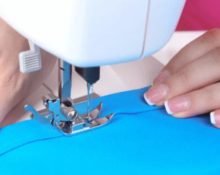Even the most successful dress or skirt model purchased in a store may need to be altered. This usually concerns the length of the product.
A straight skirt is hemmed without changing the manufacturer's technology. The hem line and the hem cut are the same length; just fold the cut of the parts and iron them. Clothing with a downward expansion has its own processing rules:
- Usually the cut is seated because after hemming there is slack on the side of the hem allowance relative to the top of the product.
- A model with a strong flare is hemmed with a Moscow seam (processing is suitable only for thin materials), a narrow hem to the width of the overlock seam, or using bias tape.
The latter option applies to a wide variety of materials and has several options.
What are the ways to finish the edge of a skirt with satin trim?
Bias tape of different colors and shades is sold in the sewing haberdashery department. If the color cannot be selected, you can make it yourself. The fabric for the bias strip is cut strictly at an angle of 45°. The strips are connected along the base (parallel to the edge of the fabric). Skirts made of thin and dense fabrics are folded in different ways:
- When hemming thin materials, the bias tape is bent in half, the fold line coincides with the bottom line of the skirt. To perform the operation, a special foot is used. The tape is tucked into the “snail” of the device, the bottom cut is located in the middle of the fold of the bias tape. A complex operation that requires precision is performed with one line. To perform a hem without a special foot, the bias tape is connected to the bottom of the product with a temporary basting stitch. Then the machine stitch is laid, and the hand stitch is removed.



- Dense and voluminous fabrics are folded with an oblique strip without the use of devices. One side of the hem of the binding is ironed and sewn down the skirt face to face. The second side is hemmed by hand or stitched with a finishing stitch from the inside of the skirt.

- The hem of the bottom of a product made of thick fabric may not coincide with the stitching line of the binding. This treatment will extend the life of the product, since the silk hem fabric will be thinner and weaker than the top fabric.

- Processing, as in a high-end atelier, includes processing with bias tape the fabric of the top of the skirt and the lining material. More time will be spent on such processing, but the result will be gorgeous.

It is these moments of edge processing that determine the quality and appearance of the product. The time spent will be more than worth it. As Coco Chanel said: “Luxury is when the inside is as beautiful as the face.”


 0
0





